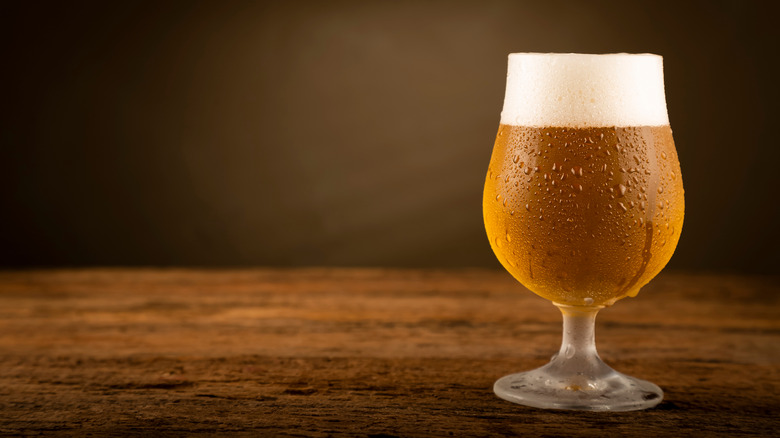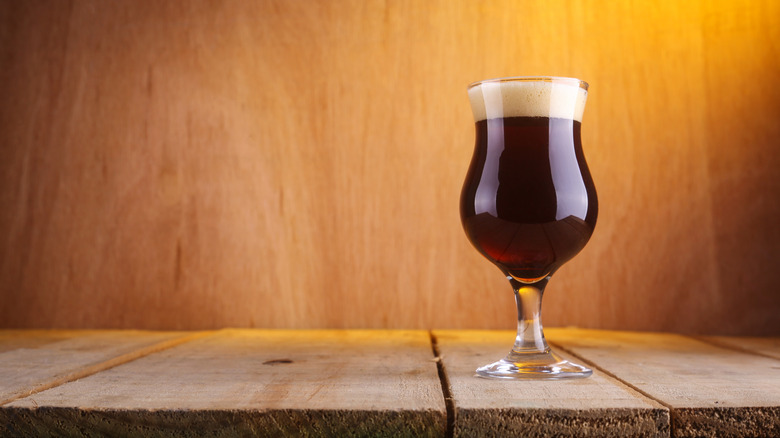The East India Company Played A Big Role In Putting IPAs On The Map
Love it or hate it, India pale ale is having a moment. Market Watch calls IPA "the face of craft beer," noting that the hazy, hoppy style grows more popular with every passing year. Trendy though it is, IPAs have a long history, and they might be unknown today were it not for the British East India Company. For Americans, the company is best known for holding a monopoly over the colonial tea trade, leading to the Boston Tea Party (via the National Constitution Center). Elsewhere in the world, and particularly in India itself, the company has a darker legacy, acting as a force of violent oppression.
Founded by royal decree in 1600, the East India Company was originally meant to facilitate the spice trade between Europe and South Asia (via History). However, by the mid-1700s it had gone far beyond that purview. Backed by an army of 260,000 — twice that of the British government itself — the East India Company seized control over much of the Indian subcontinent, laying the groundwork for the British Raj, which would control the region into the 20th century. Per Britannica, the company's transgressions included enslaving East Africans and illegally trafficking opium to support its other activities. Al Jazeera also explains how the company taxed Indians and then used those tax payments to buy Indian goods, a scam that yielded the British $45 trillion in today's money. So, where does the IPA fit into this painful history? It depends on who you ask.
The pale ale tale
As is the case with many other foods and beverages, there is some disagreement over the exact origins of IPAs. According to Wine Enthusiast, the most common version of events attributes the invention of IPA to George Hodgson, who in 1752 opened Bow brewery near the London dock where the East India Company loaded its ships. Per Smithsonian Magazine, a trip by boat from England to India took at least six months in those days, so Hodgson offered beer to the East India Company on an 18-month credit. That gave the company's ships plenty of time to travel to India, drop off some beer for the Brits living there, then return to England, laden with Indian goods for sale.
But the long months of sea travel posed another challenge — they ruined beer. Smithsonian notes that dark porter was the most popular beer in London at the time, but it wasn't cut out for a long journey to the Indian subcontinent. Packed in barrels below the ships' deck, the porter tended to spoil before reaching its destination. This is where Hodgson stepped in. According to Beer Connoisseur, the popular theory states that the brewer devised a beer with extra hops and a higher alcohol content thinking it would fare better on the journey. He turned out to be right, and his invention was called India pale ale in honor of its destination. The thing is, this story probably gives Hodgson more credit than he's due.
IPA was based on an older style
George Hodgson may have been key to popularizing the IPA, but he didn't invent anything new. Pale ales were developed in the mid-1600s when people began using coal fires to smoke malt for beer. Per Wine Enthusiast, this allowed for lighter roasts, and these "pale ales" were first shipped to India as early as 1717. These early pale ales weren't as hoppy as a modern IPA, but Hodgson didn't come up with that one on his own either. Smithsonian Magazine explains that his brew was based on an older English style called barleywine. Also known as October beer, barleywine was aged for years. Some British lords would commission a batch upon the birth of their first son, and not tap it until the boy turned 18. Since it spent so long in a barrel anyway, it made sense that barleywine would travel better than porter.
Barleywine has a lot in common with IPA, being strong and hoppy. According to Food & Wine, barleywine has a fairly high ABV, typically 8-12%. In order to make such a strong beer, brewers would use extra barley in the brew, providing more sugars to fuel fermentation. This made the beer sweeter, so brewers would add a large quantity of hops to balance the flavor. To be fair to Hodgson, Wine Enthusiast notes that he never claimed to have invented IPA. That "fact" was first published in an 1869 book, at which time Hodgson was long dead.


